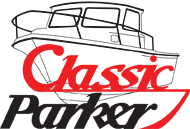DaleH
FOUNDER of Classic Parker Forum
FYI, some info I learned about using epoxy fillers from when I glassed in a new transom on my 16' skiff project, shown as a DIY tutorial, click here. With a friend of mine, we just cut the old 'step-through' transom off of his 22' deep-V Stratos CC and are putting in a new full-width, full-height transom, and adding a floatation-type OB bracket (to wear a new Suzi 250hp). Similar to what Pete (ppem45) did when his re-did his 2120SC, which now wears an OB bracket.
This is but a tidbit of comparisons/costs/benefits to the various epoxy fillers, but first a rule or two of epoxy fillers, as per Larry from Raka Epoxy (www.raka.com), citing the gospel of epoxy fillers:
Rule #1: Fillers don't COST ... they PAY by giving you greater control of your epoxy's properties and increasing the volume of your epoxy at a generally cheaper cost.
WOOD FLOUR: Good as a strong non-sagging epoxy thickener for wood-toned glues and fillets and can be mixed with fumed silica (cabosil) for a smoother paste. ~$5/lb
FUMED SILICA (Cabosil or Aerosil): Most commonly used filler, makes a very smooth, strong non-sagging putty and is often added to other fillers to improve their properties. ~$20/lb
COTTON FIBERS, Fine-Milled: An epoxy thickener for strength and gap filling properties and to makes glues with good wetting ability. < $9/lb
MICRO GLASS BALLOONS: High quality light fairing filler that sands easily. It has moderate strength and good waterproofness. It can significantly lower your epoxy cost as it will expand your epoxy volume as you mix it with the resin. ~$9/lb
PHENOLIC MICRO BALLOONS: Excellent light-weight filler for putties with superior feather edge-sanding qualities. They sand easier & smoother and have better sag resistant properties than the glass bubbles. ~$20/lb
MILLED(Fiberglass) FIBERS: A dense very high strength powdered fiberglass filler of 1/32" length. For high tensile strength putties and gap filling. < $5/lb
CHOPPED GLASS STRANDS: Fiberglass filler of 1/4" length for a very high strength rough mixture for large gap filling. Economical! (DH note, this is what Sea Ox boats were made of, no layup, simply shot into the boat mold with an appropriately named "chopper gun") < $5/lb
Then there are other specialty fillers like talc or graphite used to impart a pigment or tone to the finished color of the epoxy.
Rule #2: Use the appropriate filler for YOUR particular need and/or application ...
This is but a tidbit of comparisons/costs/benefits to the various epoxy fillers, but first a rule or two of epoxy fillers, as per Larry from Raka Epoxy (www.raka.com), citing the gospel of epoxy fillers:
Rule #1: Fillers don't COST ... they PAY by giving you greater control of your epoxy's properties and increasing the volume of your epoxy at a generally cheaper cost.
WOOD FLOUR: Good as a strong non-sagging epoxy thickener for wood-toned glues and fillets and can be mixed with fumed silica (cabosil) for a smoother paste. ~$5/lb
FUMED SILICA (Cabosil or Aerosil): Most commonly used filler, makes a very smooth, strong non-sagging putty and is often added to other fillers to improve their properties. ~$20/lb
COTTON FIBERS, Fine-Milled: An epoxy thickener for strength and gap filling properties and to makes glues with good wetting ability. < $9/lb
MICRO GLASS BALLOONS: High quality light fairing filler that sands easily. It has moderate strength and good waterproofness. It can significantly lower your epoxy cost as it will expand your epoxy volume as you mix it with the resin. ~$9/lb
PHENOLIC MICRO BALLOONS: Excellent light-weight filler for putties with superior feather edge-sanding qualities. They sand easier & smoother and have better sag resistant properties than the glass bubbles. ~$20/lb
MILLED(Fiberglass) FIBERS: A dense very high strength powdered fiberglass filler of 1/32" length. For high tensile strength putties and gap filling. < $5/lb
CHOPPED GLASS STRANDS: Fiberglass filler of 1/4" length for a very high strength rough mixture for large gap filling. Economical! (DH note, this is what Sea Ox boats were made of, no layup, simply shot into the boat mold with an appropriately named "chopper gun") < $5/lb
Then there are other specialty fillers like talc or graphite used to impart a pigment or tone to the finished color of the epoxy.
Rule #2: Use the appropriate filler for YOUR particular need and/or application ...




